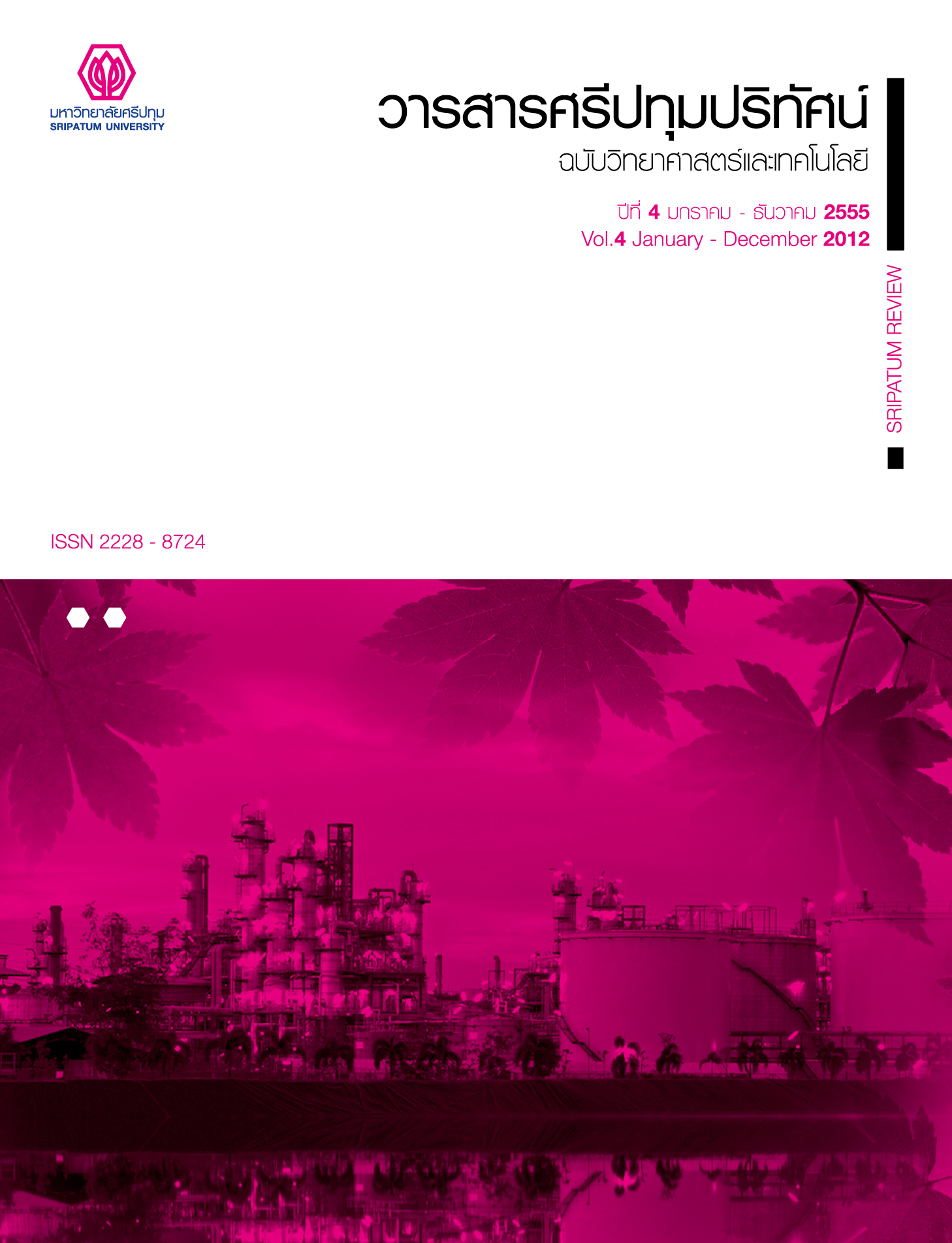ความเข้มข้นของ 1,2,4 ไตรเมทิลเบนซีนในบรรยากาศการทำงาน ของอุตสาหกรรมการผลิตสี
Main Article Content
บทคัดย่อ
งานวิจัยนี้ทำการตรวจวัดค่าความเข้มข้นของ 1,2,4 ไตรเมทิลเบนซีนในบรรยากาศการทำงาน ซึ่งเป็นสารผสมในอุตสาหกรรมผลิตสีน้ำมันของพนักงานแผนกผสมสีน้ำมัน-ทิน และพนักงานแผนกบรรจุสีน้ำมัน ทำการเก็บตัวอย่างคุณลักษณะของกลุ่มตัวอย่างด้วยแบบสอบถาม และเก็บตัวอย่างคุณภาพอากาศที่ระดับ การหายใจของพนักงาน ด้วยอุปกรณ์ดูดซับ Coconut charcoal tube และ Personal sampling pump ที่อัตราการดูดอากาศ 0.01-0.20 ลิตรต่อนาที ช่วงเวลาเก็บตัวอย่าง 08.00-12.00 น. และ 13.00-17.00 น. และวิเคราะห์ด้วย Gas Chromatography - Flame ionization detector ผลการศึกษาพบว่า ค่าความเข้มข้นของ 1,2,4 ไตรเมทิลเบนซีน ในบรรยากาศการทำงานของพนักงานแผนกผสมสีน้ำมัน-ทิน มีค่าอยู่ในช่วง <0.001-2.738 ส่วนในล้านส่วน ค่าความเข้มข้นเฉลี่ย เท่ากับ 1.094 ส่วนในล้านส่วน และค่าความเข้มข้นของ 1,2,4 ไตรเมทิลเบนซีน ในบรรยากาศการทำงานของพนักงานแผนกบรรจุสีน้ำมัน มีค่าความเข้มข้นอยู่ในช่วง <0.001-5.613 ส่วนในล้านส่วน
ค่าความเข้มข้นเฉลี่ย เท่ากับ 1.446 ส่วนในล้านส่วน ซึ่งมีค่าอยู่ในเกณฑ์มาตรฐานที่ 25 ส่วนในล้านส่วน แนะนำโดย National Institute for Occupational Safety and Health (NIOSH) และ The American Conference of Governmental Industrial Hygienists (ACGIH) จากผลการตรวจวัดดังกล่าว พบว่า ค่าความเข้มข้นของ 1,2,4 ไตรเมทิลเบนซีน ในบรรยากาศการทำงานของแผนกผสมสีน้ำมัน-ทิน และแผนกบรรจุสีน้ำมันมีค่า ไม่แตกต่างอย่างมีนัยสำคัญทางสถิติ (p <0.05)
Article Details
References
Fukaya, Y., Saito, I., Matsumoto, T., Takeuchi, Y., & Tokudome, S. 1994. “Determination of 3,4-dimethylhippuric acid as a biological monitoring index for trimethylbenzene exposure in transfer printing workers.” Int Arch Occup Environ Health, 65(5): 295-297.
Ichiba, M., Hama, H., Yukitake, S., Kubota, M., Kawasaki, S., & Tomokuni, K. 1992. “Urinary excretion of 3,4-dimethylhippuric acid in workers exposed to 1,2,4-trimethylbenzene.” Int Arch Occup Environ Health. 64(5): 325-327.
IPCS. 1996. “Environmental Health Criteria 187: White Spirit (Stoddard Solvent).” World Health Organization. Retrieved August 7, 2011.
Jarnberg, J., & Johanson, G. (1999). “Physiologically based modeling of 1,2,4-trimethylbenzene inhalation toxicokinetics.” Toxicol Appl Pharmacol, 155(3): 203-214.
Jarnberg, J., Stahlbon, B., Johanson, G., & Lof, A. 1997. “Urinary excretion of dimethylhippuric acids in humans after exposure to trimethylbenzenes.” Int Arch Occup Environ Health, 69(6): 491-497.
Kostrzewski, P., Wiaderna-Brycht, A., & Czerski, B. 1997. “Biological monitoring of experimental human exposure to trimethylbenzene.” Sci Total Environ, 199(1-2): 73-81.
Manini, P., Andreoli, R., & Niessen, W. 2004. “Liquid chromatography-mass spectrometry in occupational toxicology: a novel approach to the study of biotransformation of industrial chemicals.” J Chromatogr A, 1058(1-2): 21-37.
Ontario. 2007. “1,2,3-Trimethylbenzene 1,2,4-Trimethylbenzene 1,3,5-Trimethylbenzene.” Ontario Air Standards For Trimethylbenzenes: Retrieved August 7, 2011.
U.S. EPA. 1994. “Chemicals summary for 1,2,4-Trimethylbenzene” U.S. Environmental Protection Agency. Retrieved March 11, 2012.

